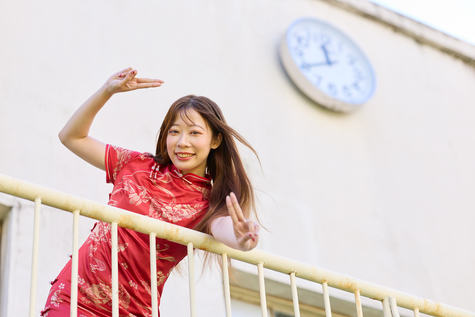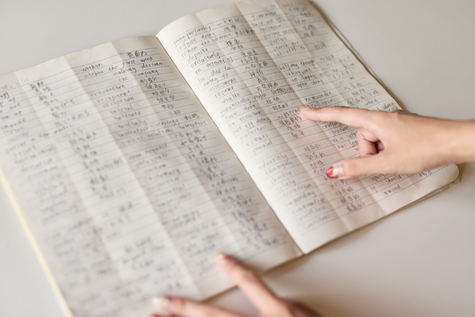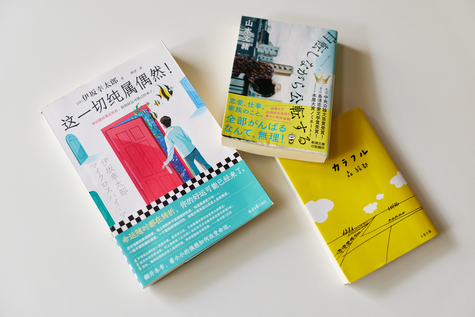Beyond Japanese-Language Education: Stories from Both Sides of the Classroom
Laughter Meets Learning: Breakout Comedian Yiran
on the Crossroads between Comedy and Study
2025.11.14
【Special Feature 087】
Yiran first moved from China to Japan at the age of nineteen to chase a dream: to become a comedian in Japan. Fast forward to January 2025, and she is on the hit variety program Chidori Kamaitachi Hour, comparing comedian Daigo's popularity in China to the Great Wall and bringing down the house─prompting top-tier comics to declare, "She's going to blow up!"
Her creative metaphors and novel word choices quickly sparked a buzz online, giving rise to what her fans call the "Yiran meme" and boosting her social media following nearly twentyfold in just six months. While passionately pursuing a career in comedy, she is also conducting graduate research in nuclear fusion at the University of Tokyo. We spoke with Yiran about her Japanese-language study and how it became a turning point in her life, opening up new possibilities for her.
It All Started with a Variety Show
Passing the JLPT N1─And Then What?
- ── Did you study Japanese before coming to Japan?
- I only began in earnest after I arrived in Japan. I was obsessed with Arashi's variety shows and adored the female comedians like Morisanchu and Harisenbon who appeared on. Watching them, I thought, "I want to do that. I want to be a comedian in Japan."
"China has its own traditional style of comedy called xiangsheng (※1), but you typically need to apprentice, so not just anyone can do it. Japanese comedy felt wide open to me, with manzai, sketches, and solo acts, and so much more─plus, at live shows, everyone builds the energy together. That was completely new to me.
"Because I had watched so much Japanese TV, I could read bits and pieces when I first arrived after high school. But speaking it? Not at all! So I set myself a specific goal: pass the highest level of the JLPT─N1 (※2). That's when I began to study seriously."
 Seeing female comedians make her beloved idol group Arashi burst out laughing, Yiran realized comedy was her path. Fueled by that passion, she passed the toughest JLPT level (N1) just three months after she began studying in earnest.
Seeing female comedians make her beloved idol group Arashi burst out laughing, Yiran realized comedy was her path. Fueled by that passion, she passed the toughest JLPT level (N1) just three months after she began studying in earnest.- ── You passed the JLPT N1 with flying colors. How did you study?
- I didn't overdo it─just one to two hours a day, steadily and consistently. I tried to combine study with what I love: for example, mimicking phrases from variety shows or jotting favorite lines from novels. Early on, I focused too much on memorizing tricky exam phrases like "de wa aru maishi" or "ikan wo towazu," but then I'd get tongue-tied in real life and couldn't say a thing! I realized input alone wasn't enough; I had to work on my output─actually using the language day to day.
Believe it or not, I'm a bit of an introvert, so when I first studied abroad, at Tokyo Metropolitan University, I struggled to make friends. That changed when I joined the Shochiku Geino training program for comedy before entering Yoshimoto Kogyo's school─I had more chances to speak Japanese. In a small class of about 20 students, I was lucky to have classmates who were patient and willing to listen to my slow, broken Japanese.
- ── Your catchphrase "More than 〇〇, there's no 〇〇!" became central to your breakout. How did it come about?
- To be honest, I didn't initially want to lean on "China" as the focus of my material. But looking objectively at my Japanese level and understanding of the culture, I realized being a Chinese woman could actually be a strength. I also wanted my punchlines to be short and powerful─making them easy to catch and remember.
In Chinese, affirmation or negation usually comes at the beginning of a sentence, so word choice drives the humor. But in Japanese it often comes at the end, so I asked myself, "What if I played with delivery and phrasing rather than the actual words?" That bit of insight led me to the catchphrase.
Still, it took a lot of courage to use it on stage. You'd never find language that rough in any "standard Japanese" textbook [laughs]! (※3)
- ── It seems that creating material takes an understanding of Japanese culture and society─not just the language itself.
I think so. Once at a drinks party, I repeated the phrase spoken by the person next to me─"Ore mo nama" (I'll have a draft beer too)─and everyone laughed. I realized that coming from a foreigner, that native phrasing made it funny!
At first, I had no idea of the cultural context behind words tied to certain generations or scenes in Japan─Sazae-san, Slam Dunk, Minato-ku joshi(※4). But as I grew familiar with their imagery, they became a part of my shared language, helping me to connect with people. That's not something vocabulary lists alone can teach you.
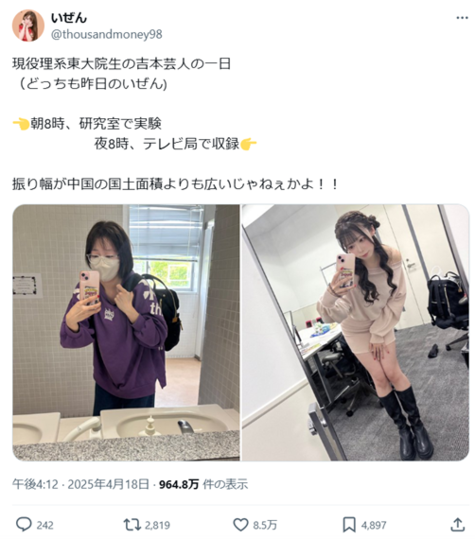 Yiran captured a day balancing research at the University of Tokyo with a TV recording in classic "Yiran meme" style─earning 85,000 likes on X .
Yiran captured a day balancing research at the University of Tokyo with a TV recording in classic "Yiran meme" style─earning 85,000 likes on X .How Japanese Deepened My Respect and Empathy for Other Cultures─and Expanded My World
- ── You're now trilingual─fluent in Japanese, Chinese, and English. How was learning Japanese a turning point?
My greatest reward from learning Japanese has been access to the culture, values, and shared assumptions behind the words. Once you understand that context, respect and empathy follow naturally.
I believe comedy works only when you truly understand and relate to a culture's shared norms and values. Only now do I feel I've finally reached the starting line as a comedian in Japan. Compared with when I first arrived, every day now feels so much more fulfilling.
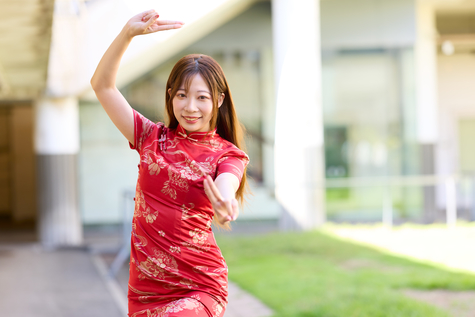 Yiran was once told by a senior Japanese comedian, "None of us can match your passion for comedy"─a compliment that still motivates her. For Yiran, Japanese study wasn't the goal─it was the tool that to realize her dream.
Yiran was once told by a senior Japanese comedian, "None of us can match your passion for comedy"─a compliment that still motivates her. For Yiran, Japanese study wasn't the goal─it was the tool that to realize her dream.I won't be able to devote as much time to comedy, but my graduate research in energy is just as important to me─I can immerse myself in it just as deeply.
Balancing comedy and graduate school helped me see Japanese society from multiple angles. A comedian on stage is cool, but so is a scientist who devotes their life to research. I think the same goes for company employees too.
Working full-time will let me understand parts of Japanese culture and society I don't yet know, and I'm sure it will inspire comedy that resonates with even more people here. Whether in comedy or elsewhere, helping others and making an impact is deeply rewarding to me, and I want to enjoy this journey.
Please watch for the new and improved me!
- (※1)Xiangsheng is a traditional Chinese comedic performance art. It often features wordplay, sound effects, and satire, with themes drawn from everyday life and society. A typical routine lasts fifteen to twenty minutes, and audiences often sip tea while watching.
- (※2)The Japanese-Language Proficiency Test (JLPT) is designed for non-native speakers. N1 is the highest level, indicating the ability to understand Japanese used in a wide range of contexts. The pass rate is around 30 percent.
- (※3)Here, "standard Japanese" refers to the Standard Japanese of China-Japan Exchanges for Beginners series (compiled by Mitsumura Tosho Publishing Co., Ltd. and People's Education Press), a long-selling introductory textbook widely used by beginners and in secondary schools in China.
- (※4)Minato-ku joshi, literally "Minato Ward women," is a slang term for stylish, socially active young women who frequent Tokyo's upscale Minato area─Roppongi, Azabu, and Aoyama─often associated with a glamorous, brand-conscious lifestyle and an active social media presence.
Back Issues
- 2025.11.14 Beyond Japanese-Lang…
- 2025.10.24 Eighty Years On from…
- 2025.6. 9 Creating a World Tog…
- 2024.10.25 My Life in Japan, Li…
- 2024.5.24 The 50th Japan Found…
- 2024.5.24 The 50th Japan Found…
- 2024.5. 2 People-to-People Exc…
- 2024.5. 2 People-to-People Exc…
- 2023.12. 7 Movie Theaters aroun…
- 2023.6.16 The 49th Japan Found…


